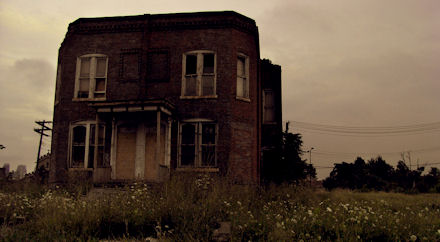Posted May 19, 2008
I had a “romantic” dream about Detroit when driving to the city for my summer job last year. If anyone has been in Detroit, he or she would know that there are many abandoned buildings. Abandoned, of course, does not mean devoid of “legal” and “private” owners. Nevertheless, what if we socialists, workers, and homeless people were to physically occupy abandoned buildings and use them as our offices, homes, and conference places, and eventually make the city into a “socialist city”?

Detroit: City of Dreams
I soon discarded my “unrealistic” (and thus “romantic”) dream and forgot about it after I was told by a couple of comrades that it would be impossible because we would not have enough resources to renovate the buildings.
But the dream came to my mind again when I was talking with a comrade from Korea, whom I met at the Labor Notes conference this year (2008) and with whom I shared my hotel room. While we were in one of the buses heading toward the American Axle plant in Detroit in order to support the workers’ strike, I happened to tell her about my “abandoned” dream while I was telling her about Detroit in which she had never previously been. Unlike my U.S. comrades, she was more enthusiastic about my dream and asked me why it would be unrealistic.
The Zapatistas or Chiapas Indigenous people in Mexico have been occupying some lands and cultivating them, although the owners of the lands have not approved the indigenous people’s action. My Korean roommate informed me that some collectivization of land has been also experimented with in Brazil during the last several years.

I wondered for a while whether occupying underutilized lands by people who do not have any resources to survive other than depending on those lands are more exercised and legitimized by people in Third World nations because the privatization process has not been as deeply rooted for long period as in advanced capitalist countries?
Mexican indigenous people remember the time when they held and used land collectively under the ejido system which began to collapse in 1991 when the IMF forced the Mexican government to privatize the land – a privatization process which created the Zapatista rebellion.
On one day in the 17th century, some peasants in Britain, agitating for a “leveling” of social and economic inequality, began to “dig” (for cultivating) privatized but un-utilized land. Due to enclosure for profit-oriented land use of sheep grazing for woolen products and privatization of property, the peasants had been deprived of “customary rights” to cultivate and live on the land and to access communal lands. This movement of the “Diggers” or “Levellers” was quelled during the English Civil War (1640s) and has been all but forgotten (see Christopher Hill’s The World Turned Upside Down).
Experiences or memories of the life before (or without) the domination of privatization and commodification of lands, resources, and labor, seem so antiquated in the U.S. that I sometimes wonder whether present U.S. workers would be able to envision what kind of life it would be?

On second thought, however, I judged myself wrong. Struggles for meaningful collective lives continuously (although not regularly) “reoccur” in various ways in history and the memories, experiences, and the new experiments of alternative ways of living, working, thinking and making new human relationships by the participants become new impulses of creating movements for socialism.
For example, as David Montgomery in his Workers’ control in America points out, the U. S. workers in the late 19th century fought for the power to “control their production processes” and tried to set their own work-rules, resisting their bosses’ attempts to increase productivity to maximize profits and destroy workers’ rules. Sympathy strikes between different craft unions in a plant and in a city were prevalent, showing their class solidarity.
This struggle for controlling workplace reflected the sense of autonomy of the craftsmanship of the traditional production process under the guild system, but strikes by which workers demonstrated their aspiration to control their workplaces and life were organized again between 1909 and 1922, and appeared again during 1934-37. Although New Deal legislation institutionalized and limited workers’ ways of fighting within the system, their determination to construct their power to control over their workplaces was shown again in some strikes and struggles in the 1970s. Each time, workers presented new ways of thinking and practicing with a mixture of the old fashions.
Therefore, the important thing is whether workers create in their own generation struggles in which they express their will to take over their workplaces and communities, experience democratic ways of thinking, and learn how to be concerned with one another as real producers of the world.
Now, turning attention back to my dream again, I have to admit that it was indeed romantic. Occupying several buildings will not change the fundamental system of production, unless it is linked to a bigger social movement that ignites a class-war for socialism. Nevertheless, the dream may generate discussions of inherent problems of the profit-oriented private property system in which resource usage is based not on human needs but on generating profits.

Comments
3 responses to “Detroit and my “romantic” dream”
The blog “for lack of better words” has posted some thoughts about this.
See:
http://forlackofbetterwords.wordpress.com/2008/08/01/more-than-just-stopping-the-locusts/#comment-2168
Check out: Object Orange.
Comrade, it’s important to dream!!!
Detroit Summer, http://detroitsummer.org/ and http://detroitsummer.blogspot.com/, a project of Grace Lee Boggs, confronts the de-industrialization of Detroit through focusing on grassroots redevelopment and youth culture organizing, with space for “multi-generational dialog.” They utilize art, poetry, and music in their program, and support a bicycle collective advocate community gardens, focusing in on the Cass corridor and taking a DIY approach like many of our self-identifying “anarchist” friends in cities across the US (yet unlike most small anarchist collectives, they do get substantial grants)
These kinds of projects along with workers’ collectives, left bookstores, and housing co-ops provide a slight glimpse: inspiration for the future world we want to build. They can sustain revolutionaries socially to overcome intense isolation brought on by capitalist alienation. But I’ve seen more than a few folks slip into a comfortable mode building these sorts of projects… and fail to confront capital or the state.
A bigger problem related to this is the left’s own isolation. One organization organizes workers on the shop floor, another works to build the welfare rights organization, another tries to build an independent political formation for working class and oppressed, while yet another organizes the people a neighborhood around a post-industrial vision.
In a world of overwhelming odds, we all try to prioritize the struggles that are most likely to win. But we do not know where a breakthrough may occur. I believe that a more open left, one that could examine, synthesize, and discuss the different groups’ experiences would lead to a stronger- and larger left one day able to win the hearts and minds of the working class and oppressed in the US.
Community gardening or beautification would not need to seem like a political choice we make against going to a union picket or anti-war event. We could simply do it individually on our day off, or perhaps collectively on Mondays and Wednesdays from 6-8.